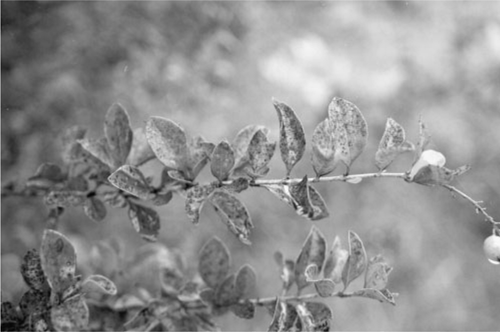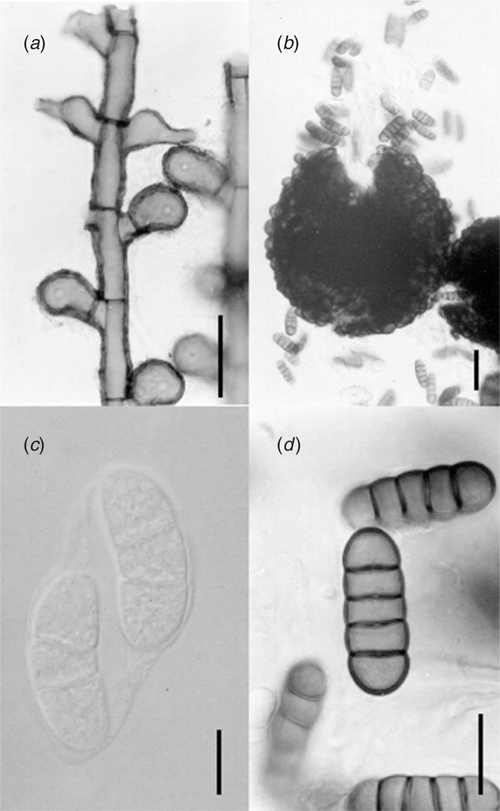First report of Asteridiella pittieri on golden dewdrop (Duranta repens var. aurea) in Brazil
O. L. Pereira A , D. J. Soares A and R. W. Barreto A BA Departamento de Fitopatologia, Universidade Federal de Viçosa, 36571-000, Viçosa, M.G., Brazil.
B Corresponding author. Email: oliparini@ufv.br
Australasian Plant Disease Notes 1(1) 17-18 https://doi.org/10.1071/DN06008
Accepted: 8 September 2006 Published: 20 September 2006
Abstract
A black mildew caused by Asteridiella pittieri (Meliolales) was observed on the foliage of the ornamental species Duranta repens var. aurea (Verbenaceae) in the states of Minas Gerais and São Paulo, Brazil. This is the first record of this fungus in Brazil. Although the impact of the disease on the host is minimal, infected plants become unsightly and, therefore, worthless for horticultural purposes.
Duranta repens L. var. aurea (golden dewdrop; local names: pingo-de-ouro, violeteira-dourada) is a shrub that belongs to the Verbenaceae and is a native of the Neotropics. It is widely used as an ornamental, particularly for hedges, because of the profuse branching, attractive golden-yellow foliage and light-blue flowers, and its tolerance to pruning (Lorenzi and Souza 1995). In February 2005, D. repens var. aurea plants were found colonised by a black mildew (Fig. 1) between the locality of Bom Conselho and Jacutinga, in the state of Minas Gerais. Later, in April 2005, additional specimens were obtained from Viçosa, also in the state of Minas Gerais and at Caverna do Diabo National Park, in the state of São Paulo. Samples of infected plant parts were collected, photographed and dried in a plant press. The fungal samples were examined with a light microscope (Olympus BX 50). All specimens were found to be attacked by the same species of black mildew fungus which is described below.

|

|
Colonies on living leaves, amphigenous, mostly epiphyllous, black, dense velvety, confluent, up to 3 mm diam., sometimes covering the entire leaf surface homogeneously. Internal mycelium not observed. External mycelium amphigenous, net-forming, slightly undulate, branching opposite at an acute to wide angle, composed of dark brown, thick walled, septate hyphae, 7.5–8.5 μm diam., closely reticulate, producing both appressoria (formerly capitate hyphopodia) and phialides (formerly mucronate hyphopodia). Appressoria bicellular, alternate, brown to dark brown, straight to slightly curved, 17.0–22.5 μm long, stalk cells cylindrical, 3.0–5.0 × 7.0–7.5 μm, head cells mostly cuneate, sometimes cylindric-clavate, rounded, 11.0–13.0 × 14.0–17.5 μm. Phialides mixed with appressoria on the same hyphae, opposite or alternate, mostly opposite, brown, ampulliform, 7.5–8.5 × 19.0–23.5 μm. Mycelial or perithecial setae absent. Perithecia black, scattered, globose, with crenate to crenulate surfaces, 135.0–235.0 μm diam. Asci unitunicate, widely elliptic, thin-walled, bearing two ascospores per ascus, evanescent. Ascospores hyaline when inside the ascus, becoming dark brown with age, narrowly elliptic, obtuse, 4-septate, constricted at septa, 13.5–17.5 × 39.5–44.0 μm, smooth.
Material examined
VIC 28729, between Bom Conselho and Jacutinga, State of Minas Gerais, Brazil, O. L. Pereira, 02 Feb. 2005; VIC 28788, campus UFV, Viçosa, State of Minas Gerais, Brazil, O. L. Pereira & D. J. Soares, 07 Apr. 2005; VIC 28789, Caverna do Diabo, State of São Paulo, Brazil, O. L. Pereira, 16 Apr. 2005.
Asteridiella pittieri is a pathogenic fungus reported exclusively on Duranta repens in Colombia, Mexico and Venezuela (Hansford 1961). The morphological features of the specimen from Brazil are consistent with those described by Hansford (1961). Despite the fact that A. pittieri is a weakly pathogenic obligate biotroph, as are the Meliolales in general (Hansford 1961; Hosagoudar 1996), infected plants become unsightly. This unsightliness was due to the black mildew covering extensive portions of the foliage which decreased the ornamental value of the host. Mendes et al. (1998) did not record the occurrence of A. pittieri in Brazil. This is, therefore the first record of this black mildew species in Brazil.
Acknowledgements
The authors thanks the Conselho Nacional de Desenvolvimento Científico e Tecnológico (CNPq) for financial support.
Hansford CG
(1961) The Meliolineae – a monograph. Beihefte Sydowia 2, 1–806.



